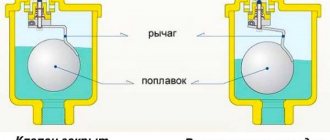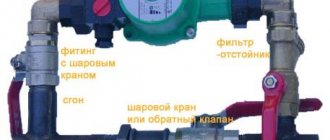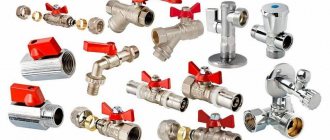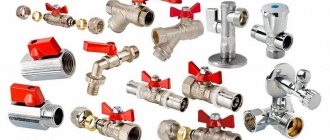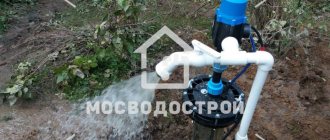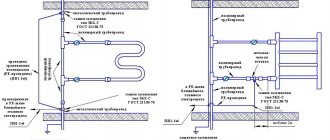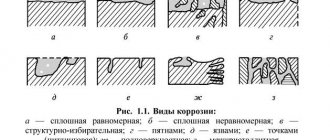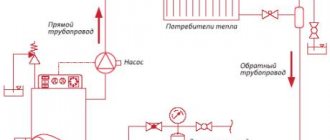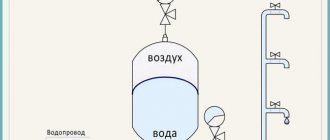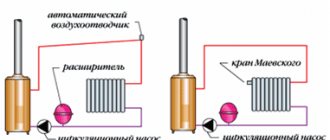Many of us have heard periodic clicks in water supply communications. But few see this as a serious threat because they do not know how devastating the consequences can be. And the situation is such that water hammer can lead not only to equipment breakdowns, but also to the formation of cracks and splits in pipes. In order to prevent this, it is necessary to strictly follow all rules for the operation of utilities. So, the topic of today’s article is water hammer in the water supply system.
Water hammer in the water supply system
- 1 Water hammer - what is it? And its consequences
- 2 Causes of water hammer
- 3 About clicks in the water supply
- 4 Threats of water hammer in water supply
- 5 How to properly deal with water hammer? 5.1 Turning off the water smoothly - will it help?
- 5.2 Another way - we upgrade the system
- 5.3 Video – Water hammer
- 7.1 Video - Water hammer in pipes
Hydraulic calculation of the heating system and its essence
Previously, we talked about how and with what programs you can independently calculate the heating system. We advise you to read this guide
Water hammer - what is it? And its consequences
Water hammer can occur in any communication (not only in the water supply) due to the practical incompressibility of water. To shut off the flow of water that flows from the faucet in the kitchen, simply turn the tap. In this case, the water will encounter an unexpected obstacle and form a reverse wave. Due to the tightness of the main line, the water has nowhere else to go, therefore, its energy will collide with oncoming flows driven by the notorious inertia. The very force of the impact resulting from such a collision is determined by the fact that compression is unable to absorb the energy arising from the interaction of flows. Although, if we talk about water pipelines of small diameter, then such phenomena appear to a minimum in them.
Photo - consequences of water hammer in the water supply and heating system
Another thing is large (both in diameter and length) rigid pipes, high flow speed, or a sudden blockage of the lumen on a certain section of the highway. In principle, such impacts can be smoothed out by special compensators or by the elasticity of the material from which the pipeline is made. Moreover, even air pockets in the circuit can absorb such surges. Although the impact energy will remain the same in all cases, it will only have less impact, which is more than enough to avoid damage.
Note! The basis of most protective mechanisms and equipment is precisely the smoothing of the force of the point of the water mass.
How to avoid water hammer in a water supply
There are several ways to prevent water hammer in an apartment and private house.
- increase the diameter of the water pipe to reduce the flow rate of water
- smooth shut-off of the water flow. pipes
How to avoid water hammer
Smooth shut-off of the water supply system
The elasticity of pipes also plays an important role, as they can deform under pressure. But it is worth noting that these measures only prolong the process, reducing its power and, accordingly, the impact on the water supply system..
All starts and stops of the pipeline must be carried out smoothly. In order to ensure a uniform change in pressure in the pipes.
Old-style valves and taps are much safer in terms of water hammer. In order to shut off the water, you will need to make several turns. Accordingly, the pressure will drop more slowly. It won’t be possible to close it abruptly even with the greatest desire,
Recently, ball valves are often used in apartments. To shut off the flow of water, just turn the tap once. Not everyone knows that the overlap must be done smoothly.
In this case, hydraulic shock will still occur. But it will break into several blows, insignificant in strength. Therefore not so dangerous.
Causes of water hammer
There are several of these:
- pump malfunction or unexpected shutdown;
- sudden closing of taps;
- air, which must be removed before activating the line filled with liquid, remains in the circuit.
Stages of water hammer
As for sudden closure, with the creation of ball devices it became the most common. After all, when liquid is supplied or shut off using obsolete screw taps, the smoothness of movement is ensured by the fact that the bottle unwinds in stages. And from a technological point of view, screw-type devices are more rational, since they eliminate the possibility of a critical increase in pressure.
The situation is similar when air was not removed from the circuit before starting. When the ball valve is suddenly opened, water collides with air, which here becomes a kind of pneumatic shock absorber. And the pops that we periodically hear and which test the pipeline for strength are ignored completely in vain. Sooner or later, a water hammer in a water supply system, capable of reaching tens of atmospheres, will cause equipment destruction.
Water hammer stages schedule
In both cases, the water flow encounters an obstacle - a shut-off valve or a banal air flow. During a collision, the water is slightly compressed, and the pipeline (including the iron one) is slightly stretched. But don't forget that there is a limit to everything.
Length of direct impact section for water shut-off valves
| № | Type of apartment fittings | Response time, s | Length of direct impact section, m | |
| For non-metallic pipeline | For metal pipeline | |||
| 1 | Lever tap or mixer | 0,05 | 8,5 | 30 |
| 2 | Shower switch (diverter) | 0,03 | 5,2 | 18 |
| 3 | Washing machine solenoid valve | 0,01 | 1,7 | 6 |
| 4 | Dishwasher solenoid valve | 0,01 | 1,7 | 6 |
| 5 | Leakage protection solenoid valve (1/2″) | 0,05 | 8,5 | 30 |
| 6 | Toilet fill valve | 0,06 | 10,5 | 36 |
Causes of water hammer and its features
So, the main cause of water hammer is a change in the speed of fluid flow in the pipe. In this case, the difference should be abrupt, that is, sharp. For example, the water supply pump turned off, or, conversely, it suddenly turned on. This will be especially felt in places where the flow of water encounters some kind of obstacle: an air bubble or shut-off valve. Liquid passes through valves and valves without problems; here its speed practically does not change, but its volume increases in front of them.
And an increase in mass is an increase in pressure in a given area, which under different circumstances can exceed 10 atm. Such excess volume must come out somewhere, and since the water supply system is partly closed, there is a high probability that the pipe in this section, especially at the junction with the shut-off valves, will rupture.
Plastic pipe after repeated water hammer
Causes of water hammer
So, the main reason has already been mentioned - turning the pump on or off. Now for the rest of the reasons.
- Air pockets that form inside the water supply pipes. Therefore, you need to get rid of them before starting work. However, it should be noted that this reason is not the main one when it comes to water supply. More often, air becomes the cause of water hammer in heating systems.
- If you suddenly close a valve or valve on the main water supply circuit. By the way, experts now note that this reason is becoming the main one, because quickly closing elements, such as ball valves, have begun to be installed in plumbing systems. And if there is an air pocket inside the pipe, then the pressure when closing the tap can rise sharply from 1 to 10. Of course, we must pay tribute to pipe manufacturers, they can withstand not such loads. But repeated pressure can destroy even them.
- Of course, power outages become, firstly, the reasons for a sudden shutdown of pumping equipment. And secondly, a sharp stop in the fluid flow rate. Accordingly, the same thing will happen with inclusion.
How to properly close shut-off valves
Consequences of water hammer
The safety of a water supply system is based on the correct approach to its design. Therefore, it is very important, when creating a water supply system, to take into account all the nuances regarding the causes of water hammer. And the most important thing is to try to create a pipe distribution in which the water does not encounter obstacles when moving, or rather, there should be as few of them as possible.
But even an installed valve in the path of water movement will not always be the obstacle that will create high pressure. After all, everything will depend on the volume of liquid that begins to collect in front of it. For example, a short pipeline or a pipe with a small diameter. In such areas, water hammer is very rare.
As for the consequences, there are quite a lot of unpleasant moments created by water hammer.
- Pipe lines are destroyed.
- The shut-off valves and pump fail.
- The premises are flooded.
- Furniture and other interior items deteriorate.
- Repair of the water supply system with full or partial replacement of pipes is required.
- The water supply to the house is interrupted for some time.
Consequences of water hammer in a water pipe
About clicks in the water supply
Periodic “clicking” sounds in pipes are heard by owners of houses where communications are not organized correctly. And it clicks mainly in those places where pipes of larger diameter are connected to pipes of smaller cross-section. In this case, water moving along the highway at a specific speed encounters an obstacle (even if it is defective). The speed subsequently does not change, the intensity of unloading decreases, the amount of liquid increases, and with it the pressure also increases. And if at such joints the water is not distributed over several registers, then due to excess pressure the pipes may burst.
Main causes of water hammer
Water hammer is a short-term, but strong and very sharp pressure drop in the pipeline.
Its occurrence is due to a sudden change in the speed of water movement in the communication system. Depending on the nature of this change, the water hammer can be negative when the speed decreases, and positive when it increases. The main danger for utility networks is the second option: with a lightning-fast increase in the speed and pressure of the working fluid, its pressure correspondingly increases, and this is fraught with pipe rupture. There are several potential causes of water hammer:
- sudden activation or deactivation of the pumping device;
- pump deformation;
- unbleeded air in a closed circuit;
Noises in the system should cause concern
- power supply problems that prevent the pump from functioning properly;
- sudden opening/closing of fittings - valves, valves and all kinds of taps.
The last reason is especially relevant today, since old pipeline valves have begun to be replaced en masse with modern high-speed ball valves. Their potential danger is explained as follows: if there is a certain volume of air in the system, then when the ball valve is opened sharply, it will inevitably collide with an almost incompressible working fluid, which will lead to a pressure jump of over 10 atm. At the same time, screw valves - the predecessors of ball devices - ensure smooth opening of the fittings, thereby eliminating the possibility of a sharp collision of air and liquid.
Threats of water hammer in water supply
As we have already found out, an obstacle created in the path of water movement creates pressure, which, from a theoretical point of view, has no critical limits. Simply put, several tens of atmospheres can be converted into a more significant figure. Rigid elements of the system, threads, and the pipeline itself will deteriorate over time (slowly or quickly) from the permanent influence of water inertia.
Note! It is long circuits that suffer more than others from water hammer - for example, a water-based “warm floor”, through the pipes of which heated liquid circulates. And to protect the system from shock, the circuit located under the floor covering is equipped with a special thermostat valve. What is typical is that this device can save systems only if it is installed correctly; in other cases, it can even create an additional threat.
As soon as the thermostat valve located in the liquid supply to the circuit is closed, the water will continue to move for some time under the influence of inertia. As a result, a vacuum is formed in this area, although the difference in indicators is very small - no more than one atmosphere. And since the circuit is designed for all four atmospheres, there shouldn’t be any problems. The valve at the outlet also blocks the movement of liquid. But when faced with such a barrier, the liquid will be supported by another portion and begin to stretch and destroy the walls of the pipeline, having a pressure of over ten atmospheres. But we digress a little, let's get back to the water supply.
How to make water heating with your own hands
We advise you to read our guide to self-installation and installation of water heating in the house. See all the details here
The consequences of constant water hammer in the system can be the most unpredictable. The most common of these is breakthrough. And nothing else if such a breakthrough occurs on an accessible section of the highway, that is, in a place where there will be no difficulties in eliminating it. But sometimes pipes are also laid in the walls, and this, of course, adds headaches.
Be that as it may, even if, as a result of a water hammer, only minor damage appears in the water supply system, the cause of such an unpleasant incident must be found. After all, sooner or later this will lead to more serious consequences.
What is water hammer in a water supply system?
Water hammer is a short-term powerful increase in the pressure of the liquid that circulates in the pipes. The pressure increases due to changes in flow speed.
The sign of the pressure change affects the type of water hammer:
BC 1xBet has released an application, now you can officially click on the active link for free and without any registration.
- positive - in which the pressure increases due to the sudden closure of the valve or the activation of the pump unit;
- negative - in which the pressure increases due to the pump stopping.
According to the laws of physics, even when the tap is suddenly closed, the water continues to move. Only the flow closest to the valve stops; the remaining layers continue to flow. The collision of the stopped and moving layers causes an increase in pressure. If you imagine that the entrance to a moving crowd has been abruptly closed, then the first rows have already stopped - the next ones bump into them, continuing to walk, the result is a crush. Water also acts, causing water hammer.
The pressure increases instantly, the level increases by several tens of atmospheres. The consequences cannot be avoided.
Water hammer theory
The occurrence of the phenomenon is possible only due to the lack of compensation for pressure drops.
A surge in one place causes a force to spread throughout the entire length of the pipeline. If there is a weak point in the system, the material may become deformed or fail completely, creating a hole in the system. The effect was first discovered at the end of the 19th century by Russian scientist N.E. Zhukovsky. He also derived a formula by which to calculate the period of time required to close the tap in order to avoid unpleasant consequences. The formula looks like this: Dp = p(u0-u1), where:
- Dp – pressure increase in N/m2;
- p – liquid density in kg/m3;
- u0, u1 are the average water speed in the pipeline before and after closing the taps.
To know how to prove water hammer in a water supply system, you need to know the diameter and material of the pipe, as well as the degree of compressibility of water. All calculations are carried out after establishing the water density parameter. It differs in the amount of dissolved salts. The speed of propagation of water hammer is determined using the formula c = 2L/T, where:
- c – designation of shock wave speed;
- L – pipeline length;
- T – time.
The simplicity of the formula allows you to quickly determine the speed of propagation of the impact, which, in essence, is a wave with oscillations of a given frequency. Now let’s talk about how to find out fluctuations per unit of time.
For this, the formula M = 2L/a is useful, where:
- M – duration of the oscillation cycle;
- L – pipeline length;
- a – wave speed in m/s.
To simplify all calculations, knowledge of the shock wave velocity upon impact for pipes made of the most popular materials will allow:
- steel = 900-1300 m/s;
- cast iron = 1000-1200 m/s;
- plastic = 300-500 m/s.
Now you need to substitute the values into the formula and calculate the vibration frequency of the water hammer on a section of a water supply pipe of a given length. The theory of water hammer will help to quickly prove the occurrence of the phenomenon and prevent possible risks when planning the construction of a house or the replacement of a plumbing or heating system.
How to properly deal with water hammer?
To protect water supply pipes from water hammer (both one-time and permanent), it is necessary to neutralize their negative impact or at least minimize it. Let's take a look at several effective ways.
Turning off the water smoothly - will it help?
According to the requirements of the central water utility, it should only be turned off/on smoothly. And the rules created for industrial-scale suppliers also apply to ordinary users. In principle, such a smooth switching on or off prolongs the duration of the blows.
The force of the blows remains the same, but it does not act for a short time, but as if in stages, distributed over a certain number of time periods. As a result, the total force of the water hammer does not change, while its power is noticeably reduced. And if we lower/increase the pressure, volume or speed of water movement smoothly, we will thereby protect the circuit from possible damage.
Another way is to modernize the system
The following steps aimed at reconstructing the system will help get rid of constant water hammer.
- Special shock-absorbing devices are installed in the direction of water movement. In other words, the section of pipe located in front of the thermostat is replaced with a similar section of plastic (plastic, as you know, is elastic) or reinforced rubber that is resistant to high temperatures. The length of the area to be replaced usually does not exceed 30 centimeters - this is quite enough. If the pipeline length is long enough, you can increase the shock absorber by about 10 centimeters.
- A shunt is inserted into the thermostat valve, the lumen of which does not exceed 0.4 millimeters. On the water circulation side, a narrow pipe with a diameter of 0.2-0.4 millimeters is placed in the thermostat. And if the system works normally, then the shunt will not affect the operation in any way, but if the pressure increases, it will smoothly reduce the indicator. Of course, only a specialist who is well versed in thermostats can do all this. Inexperienced people do not need to take on this.
Note! Shunting is applicable only for systems with new pipes made of high-quality material. But various impurities and rust will very quickly clog a small hole.
- Also, to eliminate the threat of water hammer, you can use a safety valve that will release a certain amount of water in case of excess pressure. As a result, the load on the equipment, and on the material itself, will decrease. You just need to set the function at which the valve will operate. After all, if the opening parameter is too high, then it will not be possible to prevent water hammer.
- Last option. In local water supply systems (we are talking about private houses), water hammer in the water supply system is often prevented using various types of hydraulic accumulators. Typically, these devices come complete with pumping stations and are made in the form of containers with a volume of 30 liters or more, divided inside into 2 parts (for liquid and air) by means of a special rubber membrane. If the pressure increases, then water enters the first compartment, and air, respectively, enters the second. Hydraulic shocks, by the way, are also “dumped” into this reservoir. And when the pressure returns to normal, the flexible jumper pushes the water that stretched it back into the system. According to statistics, this is the most effective way to protect against water hammer.
Video - Water hammer
As we have found out, water hammer occurs if the system is not designed correctly or operating standards are not followed. And let the noise not alarm you, but the negative consequences described in the video below should simply alert you. Therefore, it is better to eliminate the reasons in advance - this way you will save a lot on repairs.
Ways to prevent water hammer
It is almost impossible to get rid of the periodic occurrence of excess pressure in the pipeline, so the main measures are aimed at reducing its intensity and creating effective protection for pipes and other elements of the system.
Smooth adjustment
The easiest and most inexpensive way to prevent hydrodynamic shock is to use stepless adjustment. This recommendation is stated in the regulatory documentation for the operation of facilities served by a centralized supply of water and heat.
This principle can be used not only in apartment buildings, but also in the private sector, where autonomous heating systems are usually used. Due to the smooth use of shut-off valves, a sudden increase in pressure does not occur: this process is, as it were, stretched over time. As a result, while maintaining the total impact force, a reduction in its power is achieved.
It is most convenient to implement a similar method using taps with gradual blocking of the flow.
Automatic protection
It is not always possible to achieve gradual correction of internal pressure manually. More convenient and reliable in operation are automatic water hammer dampers, which are installed on pumps in forced systems.
Automation makes it possible to smoothly increase the engine speed when turning it on, and when turning it off, reduce it just as smoothly. Thus, internal pressure does not reach its maximum immediately, but after some time. At the same time, along with monitoring pressure indicators, the electronics independently regulate the pressure.
Using expansion joints
The task of the hydraulic compensator (also called a damper and hydraulic accumulator) is to accumulate fluid and absorb its excess from the circuit, which helps reduce the level of internal pressure. As a result, this makes it possible to absorb the resulting water hammer.
Note! According to European standards, equipping water supply and heating systems with hydraulic accumulators is a prerequisite.
The compensator design consists of a sealed steel tank, an elastic rubber membrane and an air valve built into it. The location of its installation is the areas of the heating circuit with the greatest likelihood of pressure surges.
Safety valve
The installation location of the safety valve with a diaphragm is a section of pipe in close proximity to the pump, immediately after the return fuse (this allows the required volume of liquid to be released in the event of excess pressure). In various device models, their activation can be carried out either by an electrical controller or by a pilot high-speed device.
The valve is activated when the pressure exceeds a safe limit, which provides reliable protection for the circulation pump in the event of a sudden stop. When dangerous internal tension reaches its maximum, the device opens 100%. After the situation normalizes, the regulator gradually closes. This way it is possible to avoid water hammer and ensure a stable rate of fluid circulation in the system.
Shock-absorbing devices
Another effective method of protecting water pipelines is the use of shock-absorbing water hammer compensators.
Most often we are talking about plastic or heat-resistant rubber pipes. Their location must coincide with the direction of movement of the coolant (the thermostat is located immediately behind such a pipe). Thanks to its elasticity, the product is able to independently remove the energy of a hydraulic shock. On average, the length of the shock-absorbing section is taken within 20-30 cm. For very long contours, the length of the reinforced rubber pipe can be increased to 40 cm.
Safety thermostat
In some situations, a thermostat equipped with special protection against power surges helps to avoid water hammer.
Inside the device there is a spring filling that separates the valve and the thermal head. During a pressure surge, the triggered mechanism prevents the valve from completely closing. As the power of the hydraulic shock decreases, the outlet gradually closes. When installing a safety thermostat, it is important not to confuse the arrow on the body and the direction of movement of the liquid medium in the pipe.
Possibility of bypass
You can make a protective thermostat yourself by equipping the thermostatic valve with a special shunt. We are talking about a thin tube with a diameter of 0.2-0.4 mm or a hole of a similar cross-section. If the system is not overloaded, the thermostat will operate normally. If internal tension appears, it will be smoothly released.
Attention! It should be borne in mind that in this way it is allowed to complete only automatic circuits with new pipes (if there are solid impurities or rust in the liquid medium, they will quickly clog the pipe).
Avoiding water hammer - basic rules
People who have encountered water hammer and know first-hand about their destructive effects are wondering: is it possible to avoid all this? There are several options, let’s take a look at each of them.
- First of all, act carefully and gently. Do not close the ball valve abruptly, otherwise a shock will occur. To avoid its appearance, close the fittings smoothly, but do not rush. Take the time to spend a few extra seconds – it’s not much compared to the upcoming plumbing repairs.
- To reduce this effect, the system can be slightly improved. As already noted, for this purpose hydraulic accumulators (also called dampers) are installed, which accumulate water in the event of an increase in pressure in the circuit.
- If shocks occur due to the pump stopping, you can install a special valve for protection. Such devices operate exclusively upon impact and reduce the growing pressure in the line. This valve is extremely reliable. It is installed next to the pump.
- Automation is another possible solution to the problem. Thanks to special control units, activation and shutdown of the system will be extremely smooth. The pump will increase or decrease pressure as necessary, which is why the risk of water hammer is practically reduced to zero.
- Finally, if water hammer occurs due to improper planning of the entire system, then the only option is to completely redesign it.
Note! If the problems are not eliminated immediately after the shocks appear, then the system will, in any case, have to be redone sooner or later. After all, if the situation repeats itself all the time, then all elements - including pipes - will soon fail. After this, repairs will cost much more.
Unpleasant consequences and methods of protection against water hammer
A barrier that suddenly appears in the path of liquid flow creates pressure, which, theoretically, can increase indefinitely. In this case, the rigid elements of the system experience severe loads and gradually or abruptly collapse.
The consequences of water hammer can be disastrous, especially for old pipelines
Accidents caused by water hammer in the heating system are accompanied by a number of characteristic troubles:
- destruction of pipelines and equipment of heating networks;
- rupture of heating devices;
- burn injuries;
- long-term interruption of heat and water supply;
- flooding of the home and damage to property.
Long pipelines, for example, heated floors, are most vulnerable to water hammer. To protect the “underground” system, it is equipped with a thermostatic valve, the installation of which must be entrusted to good specialists, otherwise another risk factor will appear in the system.
Proper protection of heating or water supply systems from water hammer is aimed at reducing their intensity and neutralizing the effects of excess pressure.
No sudden movements
The easiest way to protect yourself from water hammer is to smoothly turn on and off the shut-off valves. This nuance is clearly stated in the standards for the operation of centralized water supply facilities and heating networks. The rule can be extended to autonomous networks without any reservations.
The bottom line is that smooth switching on and off extends the process of increasing pressure over time. The energy of a water hammer does not act with all its force at once, but is distributed over several time periods. At the same time, although the total impact force remains the same, the power decreases.
Option using automation
The smooth start and stop of the engineering system can be completely entrusted to automation. Pumps with automatic speed control of the electric motor smoothly increase the pressure in the pipes after starting, and also systematically operate in the reverse order. The software equipment not only monitors pressure changes, but also automatically adjusts the pressure.
The best effect comes from a comprehensive modernization of the system, which will help prevent water hammer in the pipes. It includes a number of different activities.
Water hammer compensators, dampers, hydraulic accumulators
An important element in heating and water supply systems is a water hammer compensator (also known as a damper, also known as a hydraulic accumulator) - a device that performs three important tasks at once: accumulates (accumulates) liquid; accepts excess fluid from the system, thereby helping to reduce pressure in it; Accordingly, it helps to dampen water hammer if it occurs.
The water hammer compensator (damper) is installed in the most “dangerous” places
The compensator is a sealed steel tank with an elastic membrane and a built-in air valve. The volume can be either completely insignificant or quite large.
Interesting! In Europe, if a hydraulic compensator is not installed in the network, a warranty for household appliances, for example, a washing machine, boiler or dishwasher, is not issued.
Water hammer protection valve
To protect the pumping station in the event of a sudden stop of the pump, for example, a special diaphragm-type water hammer protection valve with a rigid seal is used. It is operated by fluid pressure and has a very useful quick pressure release feature. Install it after the check valve, at the outlet from the pipeline, next to the pump.
The water hammer protection valve has a very useful quick pressure release feature
The valve is a reliable safety device in systems under pressure.
Installation of a shock-absorbing device
Installing a shock-absorbing device (plastic or heat-resistant rubber pipe) in the direction of fluid circulation, in front of the thermostat, is an effective method of protection. The elastic material spontaneously absorbs the energy of water hammer. A sufficient length is 20-30 cm; for a very long pipeline, the shock absorber can be increased by 10 cm.
Bypass surgery at home
Anyone who is familiar with thermostat design can install a shunt with a clearance of 0.4 mm in the thermostatic valve or simply make a hole of the same diameter. Under normal operating conditions, such an innovation will not affect the system in any way, but during overloads it will smoothly reduce the pressure.
Important! Shunting as a method of protection against water hammer is applicable only to autonomous networks with new pipes. Sludge and rust from the central lines make it completely ineffective.
Can impacts be prevented?
In order not to rack your brains in the future about how to correct the situation and get rid of water hammer, the water supply system should be carefully planned and implemented in advance. To check its functionality, use a special device - a device that can simulate water hammer in the water supply system. Thanks to such a device, it is possible to identify weak points in the circuit and correct the situation before the system is put into operation.
As a conclusion
For a water supply system, water hammer can become a very serious problem. Therefore, be extremely careful when planning the system and installing its elements. Moreover, if extraneous noises are heard from the water supply, then this is a clear “symptom” of a problem that should be solved immediately, without delay.
Other ways to combat water hammer
One of the possible options for neutralizing water hammer has already been voiced - close the taps smoothly. But this is not a panacea, and it is inconvenient in our fast-paced times. And there are also household appliances, you can’t teach them. Although, some manufacturers take this point into account, and the latest models are made with a valve that smoothly shuts off the water. This is why compensators and neutralizers are becoming so popular.
Water hammer compensator - a small device (comparison with a brass ball valve)
You can combat water hammer using other methods:
- When installing or reconstructing water supply or heating systems, insert a piece of elastic pipe in front of the source of water hammer. This is reinforced heat-resistant rubber or PPS plastic. The length of the elastic insert is 20-40 cm. The longer the pipe, the longer the insert.
- Purchase of household appliances and shut-off and control valves with smooth valve movement. If we talk about heating, problems with warm water floors are often observed. Not all servos operate smoothly when closing the flow. The solution is to install thermostats/thermostats with a smooth piston stroke.
- Use pumps with soft start and stop.
This is what water hammer protection devices look like in heating and water supply systems
Water hammer is a truly dangerous thing for a closed system. He breaks radiators and bursts pipes. To avoid problems, it is better to think through control measures in advance. If everything is already working, but problems arise, the smartest and easiest way is to install compensators. Yes, they are not cheap, but repairs will cost more.
